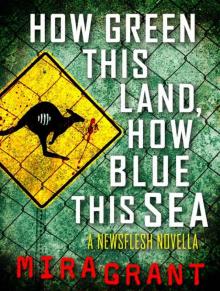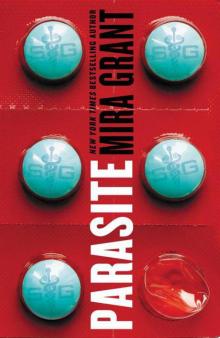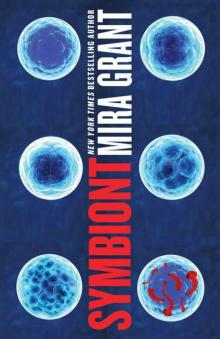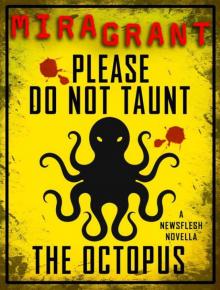- Home
- Grant, Mira
Symbiont (Parasitology Book 2)
Symbiont (Parasitology Book 2) Read online
orbitbooks.net
orbitshortfiction.com
Begin Reading
Table of Contents
Orbit Newsletter
Copyright Page
In accordance with the U.S. Copyright Act of 1976, the scanning, uploading, and electronic sharing of any part of this book without the permission of the publisher constitute unlawful piracy and theft of the author’s intellectual property. If you would like to use material from the book (other than for review purposes), prior written permission must be obtained by contacting the publisher at [email protected]. Thank you for your support of the author’s rights.
This book is dedicated to Aislinn Suzanne Ellis, who had the excellent sense to be born while it was being written.
Welcome to the world, my dearest skeleton girl.
INTERLUDE 0: MEIOSIS
Knowing the direction doesn’t mean you have to go.
–SIMONE KIMBERLEY, DON’T GO OUT ALONE
Boom boom pow, bitches.
–TANSY (SUBJECT VIII, ITERATION II)
November 3, 2027: Time stamp 17:27.
[The recording is substandard, clearly done on a cellular telephone or cheap tablet, rather than any form of professional camera. The lab on the screen looks like it was assembled in a junkyard: mismatched equipment, sputtering lightbulbs, and personnel in stained scrubs that have clearly been worn for several weeks without being washed. All of them have their faces turned away, save for the central figure in the shot, a woman in a wheelchair. Her wavy blonde hair hangs limp around her face but her lab coat is surprisingly clean, given the chaos surrounding her. A palpable air of exhaustion hangs around her. She has clearly made an effort to tidy herself up, to adhere to modern standards of attractiveness, but nothing will disguise the bags beneath her eyes, or the faint pallor of her skin.]
DR. CALE: My name is Doctor Shanti Cale. I am one of the original creators of the Diphyllobothrium symbogenesis organism, more commonly known as “the SymboGen implant,” although I suppose that if anyone’s talking about it today, you’re calling it the cause of the sleepwalking sickness. My co-creators were Doctor Richard Jablonsky, deceased, and Doctor Steven Banks, whose whereabouts are currently unknown to me. I suppose he’s still safely tucked away inside his corporate fortress. I know I would be, in his position.
[She pauses, takes a breath, and visibly steadies herself as she returns to her original tone of calm professionalism.]
DR. CALE: I am not trying to shift or dodge any of the blame that is due to me. This confession—the confession of my involvement—appears at the front of every recording we have made since the war began. You will not find information to exonerate me. You may find more proof that I should be reviled by history. It’s all right. The broken doors are open now, and I was the one who opened them.
[She grips the wheels of her chair, rolling herself to the side of the shot. The camera does not follow her movement; the recording device is apparently propped on a table or counter. There is a brief blur off to one side as one of the technicians passes through the frame; her face has been pixelated to obscure her identity.]
DR. CALE: At the end of this introduction, the video feed will switch to a compressed data format. Using the following data decryption code will allow you to extract and analyze this week’s findings.
[She holds up a small whiteboard. On it is written a string of apparently meaningless letters and numbers. She is careful to hold the whiteboard so that all figures are clearly visible in the shot.]
DR. CALE: I’m afraid this week’s results have been less than encouraging. We have retrieved and analyzed four of the so-called “sleepwalkers” affected by the active stage of the D. symbogenesis parasite. All of them demonstrated physiological difficulties, as well as unpredictable and irrational behavior. Analysis of the subjects showed that there had been extensive damage to the soft tissues of the brain and spine during the takeover process, resulting in a host that was unable to reach an accord with the invasive parasite. Unless D. symbogenesis finds a way to begin infiltration earlier in its life cycle, we will continue to see individuals who have been damaged in this manner. At this point, neither the original human host nor the invasive parasite will be able to utilize these subjects as fully functional beings. They are failures of evolution. They are dead ends.
[Dr. Cale pauses and puts the whiteboard down, rubbing her face with the heel of her hand. In that moment, she looks more tired, and more human, than she has since the video began.]
DR. CALE: There are those who will interpret my decision to open these videos with a confession as an admission of guilt. It’s not. I just need you to know that my data is as good as it’s possible for anyone’s data to be, and if there’s blame to be given, I need it to fall on me. But I’m not guilty. Guilt involves feeling like you did something wrong, and while I am most definitely to blame, I’m not guilty.
[She smiles, a little sadly.]
DR. CALE: I don’t know who’s watching these videos, if anyone is. Maybe it’s someone from the human side, and maybe it’s someone from the D. symbogenesis side, and I’m not going to say which side it is that I’m rooting for, because honestly, even I don’t know anymore. I know that I did good work. I know that I made a lot of lives better with what I did. I know that I love my children—all of them, no matter what species they are. I know that I am sorry for what’s happening right now, but nothing that happens is ever going to make me regret that I created them.
[Her attention switches briefly to something outside the shot. She makes a gesture with her right hand, which appears to be American Sign Language for “okay.” Then she nods, turning back to the camera.]
DR. CALE: Whoever you are, we’re ready for you. May you put this information to good use. May you find a way to thrive. And may you, and everything you love, make it through the days ahead alive.
[She grips her wheels and rolls toward the camera, swerving just before she would have run into whatever is holding it. There is a brief stutter in the picture, as if the image were compressing, and the lab is gone, replaced by a several-megabyte flood of data. This onslaught of encoded information continues for ninety seconds before the visual feed abruptly terminates. The audio continues for a few seconds more, then ends.]
[End report.]
September 13, 2027: Time stamp 18:21.
This is not the beginning of the end.
This is the beginning of the recognition of the end; this is the point at which the world could no longer afford to pretend that nothing was wrong. The end began in a thousand places at the same time, sending little cracks through the foundation of mankind’s casual dominion over the earth. It was born of hubris, and it started slowly, only to gather in both speed and strength as the days went by. No one who noticed had the power to stop things, and by the time more eyes were on the problem, it was too late.
This is not the beginning of the end. But it is the end of the beginning.
Paul Moffat was dying.
Externally, he seemed to be the very picture of health, the sort of man who could still run marathons and climb mountains, despite being well into his fifties. He had been cited repeatedly as one of the Bay Area’s most attractive movers and shakers—an honor that was only partially paid for by his press secretary. As mayor of San Francisco, he had to keep himself looking his best. As someone who was starting to look thoughtfully at the Governor’s Mansion, he couldn’t afford to slip up even a little. Thank God for SymboGen. Not only were they generous contributors to his war chest—and let’s face it, there was always room for another million dollars tucked into the rumble money—but they took care of their friends. His implant was top of the line, genetically engineered for maximum
compatibility with his biological profile. His health wasn’t something he was willing to gamble with.
“Every man in my family has had allergies, even unto the seventh generation,” he said, winning himself a laugh from the largely conservative crowd. They appreciated a good Bible reference every now and then, as long as he didn’t go too far and start to slip into proselytizing. The heady days of the twenty-teens were behind them, and while God still had a place in the American heart, He was increasingly less welcome in the political arena. No one wanted to be perceived as trying to drum up another Tea Party. But a few little reminders that Paul Moffat was a man of faith always went over well. “Me, I have two dogs. Big shaggy things. My kids love them, my wife—or at least my wife’s vacuum cleaner—hates them, and you know what? I’ve never had so much as a sniffle. You could say ‘there’s a man who’s had good luck,’ but I know better.”
Paul paused, smiling genially at the crowd, giving them time to snap the pictures he knew they were aching to take of him. Man of the people, politician you can talk to—he was happy to take whatever title they wanted to apply to him, as long as it was a positive one—and he worked hard to make sure that they were always positive.
Later, the few people who were able to review their shots would notice the odd lack of focus in his eyes, or the way the corner of his mouth was twitching—just a little, not enough to see with the naked eye, but more than enough for the camera to catch. The camera was always looking, and unlike Paul himself, it was never going to lie. Not for the sake of expediency. Not for the sake of anything.
In Paul Moffat’s descending aorta, something moved.
Progress through the body was slow, especially for something the size of a mature D. symbogenesis tapeworm. Paul’s implant was more than three feet in length, slightly thicker than a ribbon—a ribbon that moved in small, fluid undulations. It pulled itself along more through instinct than anything else, heading inexorably toward the only destination that could fulfill its instinct to protect its newly forming sense of self. The blood flowing around it pushed it backward, but it persevered. Although this implant did not know it, it was the third to have attempted the long, slow transit through the body of Paul Moffat. The first two had chosen the vena cava as a safer means of transport, mistakenly risking their lives on what seemed, in their mindless questing, to be a kinder current. The deoxygenated blood had killed them as surely as they had intended to kill their host. They had decayed and been flushed from the body with no one the wiser.
But this worm, the third worm, burrowed from Paul Moffat’s digestive tract up into the largest vein in the body, the vein responsible for carrying life-giving oxygen to the rest of the organism. Passage was slow. That didn’t matter. It was, by that stage in the process, also inevitable.
“You see, when I was a boy, I was so allergic to anything with fur that we couldn’t even take me to the state fair. Can you imagine that? An all-American boy unable to attend his own state fair because just getting within two hundred yards of the 4-H exhibits would see him sneezing his face off.” Paul paused for effect. The audience laughed uproariously.
The pause stretched longer. Paul opened his mouth to continue with his anecdote, and froze. The world seemed to have gone out of focus while he was catching his breath, and now he couldn’t get it to come back.
Inside Paul’s body, the implant had reached the end of its long and arduous journey. Bit by bit, it forced itself through the small opening at the base of his skull, shoving and chewing its way into the space that would be its new home. With every bite it took, a little more of Paul Moffat—who he had been, who he had dreamt of becoming—was devoured, gone to feed the worm that he had willingly nurtured in his own flesh.
His mouth closed, only to open again. No sound emerged. His aides, who had been relaxed and enjoying the familiar sight of the mayor in his element, began to tense and watch him carefully for some sign of what was going on.
They couldn’t see the true problem. The body of the implant blocked vital blood flow to the brain, causing minor lesions and cell death, even as the worm itself chewed larger holes into the surrounding tissue.
By the time Paul Moffat moaned and shambled down from the platform, arms outstretched and grasping for the people in the front row, the man he had been was quite mercifully dead. He would not see his body biting into the throat of a local businesswoman; he would not be aware of the pheromone signals his skin was now emitting as they began to awaken the sleeping parasites in the people around him. He was, in his own strange way, spared.
The rest of the world was not so lucky.
STAGE 0: PROPHASE
When looking for someone to trust with your health, choose SymboGen. Because if you can’t trust Nature, who can you trust?
–FINAL SYMBOGEN ADVERTISING SLOGAN
Here I am.
–SAL MITCHELL
—I repeat, the city of San Francisco has been compromised. Reports of infected individuals are coming in from all parts of the county, and attacks have been witnessed on buses, trains, and ferries heading into other parts of the Bay Area. At the current rate of exposure, all infection-prepped individuals will be compromised within the next twenty-four hours. USAMRIID’s evacuation efforts are ongoing, and are centered around the organization’s Treasure Island base. Other rescue and evacuation efforts have been put in place by state and local authorities, but all have thus far failed to gain traction. In several cases, members of the rescue teams have joined the sleepwalkers in their attacks.
The CDC has a team incoming, and all staff currently on the grounds are being scanned for signs of tapeworm infection. Antiparasitics are being handed out by the doctors, along with any prescription medicines which will become necessary once the worms have been purged. It’s unclear how much good this is going to do. No one knows how far the infection has already gone.
God, my head hurts.
–FINAL TRANSMISSION OF PRIVATE CODY ANDROS, OCTOBER 3, 2027
The structure of the evolving D. symbogenesis parasite is as fascinating as it is horrifying. It seems to change from generation to generation, belying the asexual nature of classic tapeworm reproduction. I’m not sure where the tendency toward mutation was introduced—it doesn’t match with any of the admitted genetic sources, and Mom has no reason to lie to me at this point. She got what she wanted, after all. We’re here, with her, and the tapeworms are taking over the world.
That’s not fair. I’m sure this isn’t what she wanted. I’m sure she had more sense than this. At least, I want to be sure…
–FROM THE NOTES OF DR. NATHAN KIM, OCTOBER 2027
Chapter 1
SEPTEMBER 2027
Dr. Cale’s lab might have been concealed in an abandoned bowling alley, but she’d clearly never seen that as a reason for her equipment to be anything less than state-of-the-art. The MRI scanner was kept in a private room, and was as elaborate and complex as anything they had at SymboGen. I tried to focus on how surprising it was to see a piece of machinery that complicated in a place like this as I shed my clothing on the floor and allowed Nathan to help me into the scanning bed. I’d been through this process before. It made it easy for me to lie still and close my eyes, pretending that none of the last few weeks had happened; that everything was still normal, that I was still me, and not the thing that I was desperately afraid I was becoming. Or worse, the thing I was even more afraid I had been all along.
The MRI came to life around me, the hammers and clangs of the vast machine blending with the insistent pounding of the drums in my ears until there was nothing else: just sound, vibrating through my flesh, anchoring itself beneath my sternum. My flesh, my sternum. Ownership was so easy to claim, but did I have any right to it?
Please, please, it’s something else, I thought, lying to myself one last time while the option was still open to me. Please, it’s not what I think it is. Please, there’s another answer…
The MRI gave one final pulse as it shut off. The sudden silence w
as deafening, only slightly lessened by the hum of the automated scanning bed sliding back out into the room, where the chill air raised goose bumps on my arms and legs. I grabbed a lab coat off the side of the machine, pulling it on as I climbed back to my feet. It didn’t do much to cut the chill, but I didn’t want to spend the time to pick up my clothes.
Nathan was seated at the monitor, the display reflecting off his glasses as he pulled up the first images of my insides. I stopped behind him, putting my hand on his shoulder. He put one of his hands over mine, using the other to continue working the mouse.
My abdomen should have been occupied by a lot of things: organs, scarring, and the pasty white mass of the SymboGen implant, which would naturally gravitate toward the base of my digestive system. It wasn’t there. The blood tests had been telling the truth: there was no residual tapeworm protein in my blood because there was no tapeworm in my digestive system. Nathan clicked to the next image. It wasn’t in my lungs, either. The image after that proved that my spinal cord was clean.
His fingers tightened on mine. I think that if I had told him to stop then, he would have, and we would both have walked away with the question unanswered. I didn’t tell him to stop. I needed to know. He did too, if only so that we would both be standing in the same place for once.
Nathan clicked the mouse. Everything changed.
The image showed the inside of a human skull, normal save for some small remodeling of the bone toward the back. The brain was there, lit up in bright colors that represented activity during the MRI. The tapeworm was there too, showing up as loops of nonreactive white against the bright neural map. It was deeply integrated, slithering in and out of brain tissue. But I’d known that before I’d seen the image, hadn’t I? I’d figured it out when I met Adam and Tansy, when I was faced with the reality of their existence. When I’d started to care about them, despite their monstrous origins.

 How Green This Land, How Blue This Sea: A Newsflesh Novella
How Green This Land, How Blue This Sea: A Newsflesh Novella Parasite (Parasitology)
Parasite (Parasitology) Symbiont (Parasitology Book 2)
Symbiont (Parasitology Book 2) Please Do Not Taunt the Octopus
Please Do Not Taunt the Octopus